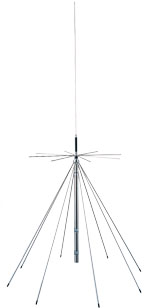Difference between revisions of "Discone Antenna"
| Line 1: | Line 1: | ||
A discone antenna is omnidirectional, vertically polarized and with gain similar to a dipole, it is exceptionally wideband, offering a frequency range ratio of up to approximately 10:1. The radiation pattern in the horizontal plane is quite narrow, making its sensitivity highest in the direction of the horizon and rather less for signals coming from relatively close by. | A discone antenna is omnidirectional, vertically polarized and with gain similar to a dipole, it is exceptionally wideband, offering a frequency range ratio of up to approximately 10:1. The radiation pattern in the horizontal plane is quite narrow, making its sensitivity highest in the direction of the horizon and rather less for signals coming from relatively close by. | ||
| + | |||
| + | [[File:discone_d3000n.jpg]] | ||
| + | ''Illustration: This discone is designed for 25MHz to 3000 MHz receive and can be used to transmit starting at the 6m ham band due to the addition of the whip on the top.'' | ||
Discone signal gain is achieved by compressing the radiation pattern into a donut shape with little of the signal radiating upwards or downwards, concentrating the pattern perpendicular to the vertical axis of the antenna. | Discone signal gain is achieved by compressing the radiation pattern into a donut shape with little of the signal radiating upwards or downwards, concentrating the pattern perpendicular to the vertical axis of the antenna. | ||
Latest revision as of 20:44, 10 February 2016
A discone antenna is omnidirectional, vertically polarized and with gain similar to a dipole, it is exceptionally wideband, offering a frequency range ratio of up to approximately 10:1. The radiation pattern in the horizontal plane is quite narrow, making its sensitivity highest in the direction of the horizon and rather less for signals coming from relatively close by.
 Illustration: This discone is designed for 25MHz to 3000 MHz receive and can be used to transmit starting at the 6m ham band due to the addition of the whip on the top.
Illustration: This discone is designed for 25MHz to 3000 MHz receive and can be used to transmit starting at the 6m ham band due to the addition of the whip on the top.
Discone signal gain is achieved by compressing the radiation pattern into a donut shape with little of the signal radiating upwards or downwards, concentrating the pattern perpendicular to the vertical axis of the antenna.
The discone is often the choice for use with a police scanner. Although a discone is the best for all around scanning antenna, it is not as optimal for lower frequencies such as those used by CB and HF ham radio.
The discone can also be used to transmit depending on the design. Consider an omnidirectional capable of transmitting on ham radio bands 50, 144, 220, 432, 900, and 1200 MHz on the same antenna, which is all possible with the right discone. However, as a transmitting antenna, it is often less efficient than an antenna designed for a more limited frequency range.
As mentioned above, low frequency use is less efficient using a discone. This has been compensated for on some designs by the addition of a long vertical whip on the top center of the disc which extneds low frequency response. The compromise to doing this is some sensitivity loss at higher frequencies.